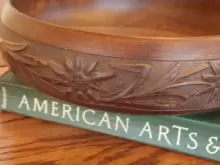Asheville: A City of Many Biltmores

While there is only one iconic Grove Park Inn, Asheville has a plethora of both contemporary and historic sites linked to the name Biltmore. As you are planning your journey to Asheville for the national Arts and Crafts Conference and Shows to be held February 21-23, this brief explanation of “The Original Three Biltmores” may prove helpful.
Biltmore House & Estate – Completed in 1895 by George Vanderbilt, this 250-room mansion was designed by Richard Morris Hunt as a towering French chateau on a bluff surrounded by a 125,000-acre estate. Still in the original family and open to the pubic since 1930, it now draws a million visitors a year to the house, grounds, gardens, shops, restaurants, and winery. Give it the five to six hours it deserves and you will have a little journey you will never forget. Filled with rare fine art and exquisite antiques (but too early for Arts and Crafts!), it is located approximately four miles south of the Grove Park Inn, easily accessed by car or taxicab. For more information, see http://www.Biltmore.com.
Biltmore Village – This quaint collection of ca. 1900 cottages and businesses was owned by George Vanderbilt and designed for his employees by Englishman and famed Arts and Crafts architect Richard Sharpe Smith, who upon Hunt’s death became Vanderbilt’s personal and Asheville’s most prolific architect. Located outside the entrance to the estate, its original structures are characterized by half-hewn timbers and pebbledash exteriors. The buildings have since been transformed into shops, galleries, and restaurants (pictured), ideal for walking along the tree-lined brick sidewalks on a nice day. Go to http://www.BiltmoreVillage.com.

Biltmore (Estate) Industries – Founded and financed by George and Edith Vanderbilt in 1905 as an Arts and Crafts cottage industry for the children of their employees, its workshops and showroom for homespun cloth, hand-carved bookends and bowls, and some furniture were located in Biltmore Village from 1905 until 1917.
In 1917, Edith Vanderbilt sold the business to Frederick L. Seely, designer and president (but not owner) of the Grove Park Inn. Seely built five Arts and Crafts workshops on the grounds of the Grove Park Inn and moved the workers and equipment there in 1917, shortening the name to Biltmore Industries.
Seely was ousted from the G.P.I. in 1927, but then concentrated on his management of the weavers and woodcarvers at Biltmore Industries until his death in 1942. Although it struggled for several decades, the buildings did survive intact and have recently been restored and revitalized, now serving as a museum, a café, an award-winning gallery, an antique car museum, and several workshops for artisans. This Arts and Crafts enterprise is so special and unique that daily free tours are included as part of the agenda for the Arts and Crafts Conference. The shopmark-branded bowls (pictured) and bookends, hand-carved with natural motifs, are highly collectible, and are often found in Asheville antique shops and in the Grove Park Inn antiques show. See http://www.Grovewood.com.

Only one Grove Park Inn, but three famous Biltmores.
Oh, did I mention Biltmore Baptist, Biltmore Fitness, Biltmore Groceries, Biltmore Iron & Metal, Biltmore Plastic Surgery, Biltmore Saddle, Biltmore Wheel Alignment, Biltmore Upholstery, Biltmore Tool, Biltmore Marble, Biltmore Medical, and Biltmore Bolts & Nuts?
Until next Monday,
It’s all in a name ….
Bruce
For conference info, just click on http://www.Arts-CraftsConference.com.
